Ex-24.1, Data Handling III Construction Of Bar Graphs, Class 7, Math RD Sharma Solutions | RD Sharma Solutions for Class 7 Mathematics PDF Download
Question 1:
Two hundred students of class VI and VII were asked to name their favourate colours so as to decide upon what should be the colour of their school house. The results are shown in the following table.
| Colour: | Red | Green | Blue | Yellow | Orange |
| Number of students: | 43 | 19 | 55 | 49 | 34 |
Represent the given data on a bar graph.
(i) Which is the most preferred colour and which is the least?
(ii) How many colours are there in all?
Answer 1:
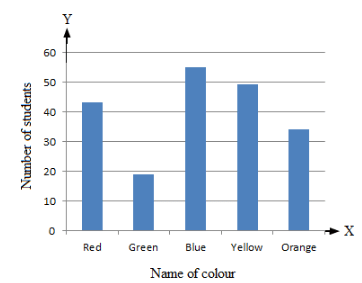
Mark the horizontal axis OX as “Name of the Colour” and the vertical axis OY as “Number Of Students”.
Along the horizontal axis OX, choose bars of uniform (equal) width, with a uniform gap between them.
Choose a suitable scale to determine the heights of the bars, according to the space available for the graph. Here, we choose 1 small division to represent 10 student.
Answers:-
(i) The most preferred colour is blue and the least preferred is green.
(ii) In all, there are 5 colours.
Question 2:
Following data gives total marks (out of 600) obtained by six children of a particular class.
| Student: | Ajay | Bali | Dipti | Faiyaz | Gotika | Hari |
| Marks obtained: | 450 | 500 | 300 | 360 | 400 | 540 |
Represent the data by a bar graph
Answer 2:

Mark the horizontal axis OX as “Name of the Students” and the vertical axis OY as “Marks Obtained”.
Along the horizontal axis OX, choose bars of uniform (equal) width, with a uniform gap between them.
Choose a suitable scale to determine the heights of the bars,according to the space available for the graph.Here, we choose 1 small division to represent 100 marks
Question 3:
Number of children in six different classes are given below. Represent the data on a bar graph.
| Class: | V | VI | VII | VIII | IX | X |
| Number of children: | 135 | 120 | 95 | 100 | 90 | 80 |
(i) How do you choose the scale.
(ii) Which class has the maximum number of children?
(iii) Which class has the minimum number of children?
Answer 3:
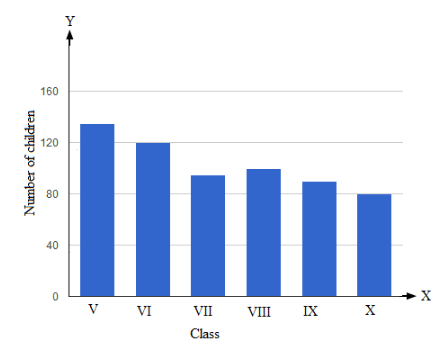
Mark the horizontal axis OX as “Class ” and the vertical axis OY as “Number of Children”.
Along the horizontal axis OX, choose bars of uniform (equal) width, with a uniform gap between them.
Choose a suitable scale to determine the heights of the bars,according to the space available for the graph.Here, we choose 1 big division to represent 40 children.
(i) We choose 1 big to represent 40 children.
(ii)The maximum number of students are in class V.
(iii) The minimum number of students are in class X
Question 4:
The performance of students in 1st term and 2nd term is as given below. Draw a double bar graph choosing appropriate scale and answer the following:
| Subject: | English | Hindi | Maths | Science | S.Science |
| 1st term: | 67 | 72 | 88 | 81 | 73 |
| 2nd term: | 70 | 65 | 95 | 85 | 75 |
(i) In which subject, has the children improved their performance the most?
(ii) Has the performance gone down in any subject?
Answer 4:
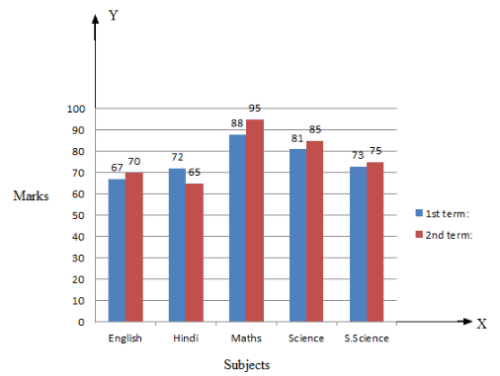
We choose 1 small division to represent 1 child in the graph.
Mark the horizontal axis OX as “Subject” and the vertical axis OY as “Marks”.
Along the horizontal axis OX, choose bars of uniform (equal) width, with a uniform gap between them.
Choose a suitable scale to determine the heights of the bars,according to the space available for the graph. Here, we choose 1 big division to represent 10 marks.
Answers :-
(i) In Maths, the students showed their greatest improvement.
(ii) The students performed worst in Hindi.
Question 5:
Consider the following data gathered from a survey of a colony:
| Favourate Sport: | Cricket | Basket-Ball | Swimming | Hockey | Athletics |
| Watching | 1240 | 470 | 510 | 423 | 250 |
| Participating | 620 | 320 | 320 | 250 | 105 |
Draw a double bar graph choosing an appropriate scale. What do you infer from the bar graph?
(i) Which sport is most popular?
(ii) What is more preferred watching or participating in sports?
Answer 5:
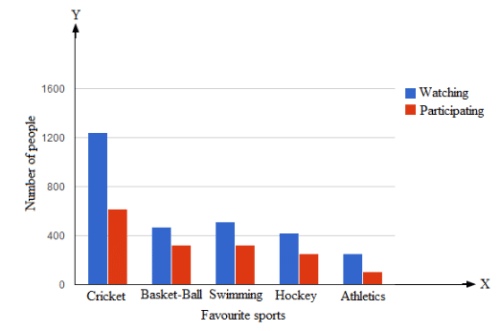
Mark the horizontal axis OX as “Favourite Sports” and the vertical axis OY as “Number of People”.
Along the horizontal axis OX, choose bars of uniform (equal) width, with a uniform gap between them.
Choose a suitable scale to determine the heights of the bars,according to the space available for the graph.Here, we choose 2 big division to represent 400 people .
(i) Cricket is the most popular sport.
(ii) Watching is preferred over participation.
Question 6:
The production of saleable steel in some of the steel plants of our country during 1999 is given below:
| Plant | Bhilai | Durgapur | Rourkela | Bokaro |
| Production (In thousand tonnes) | 160 | 80 | 200 | 150 |
Construct a bar graph to represent the above data on a graph paper by using the scale 1 big division = 20 thousand tonnes.
Answer 6:
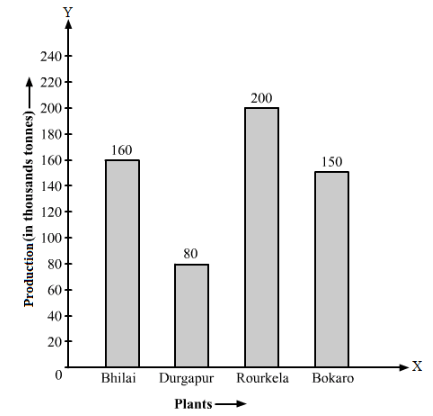
Mark the horizontal axis OX as “Name of the Steel Plant” and the vertical axis OY as “Production (in thousand tonnes)”.
Along the horizontal axis OX, choose bars of uniform (equal) width,with a uniform gap between them.
Choose a suitable scale to determine the heights of the bars,according to the space available for the graph.Here, we choose 1 big division to represent 20 thousand tonnes.
Question 7:
The following data gives the number (in thousands) of applicants registered with an Employment Exchange during, 1995-2000:
| Year | 1995 | 1996 | 1997 | 1998 | 1999 | 2000 |
| Number of applicants registered (in thousands) | 18 | 20 | 24 | 28 | 30 | 34 |
Construct a bar graph to represent the above data.
Answer 7:
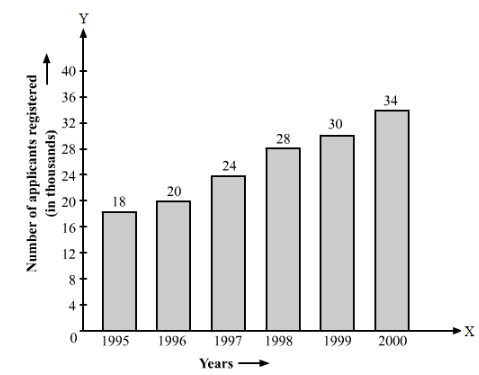
Mark the horizontal axis OX as “Years” and the vertical axis OY as “Number of Applicants Registered (in thousands)”.
Along the horizontal axis OX, choose bars of uniform (equal) width, with a uniform gap between them.
Choose a suitable scale to determine the heights of the bars, according to the space available for the graph. Here, we choose 1 big divisions to represent 4 thousand applicants.
Question 8:
The following table gives the route length (in thousand kilometres) of the Indian Railways in some of the years:
| Year | 1960-61 | 1970-71 | 1980-81 | 1990-91 | 2000-2001 |
| Route length (in thousand kilometres) | 56 | 60 | 61 | 74 | 98 |
Represent the above data with the help of a bar graph.
Answer 8:
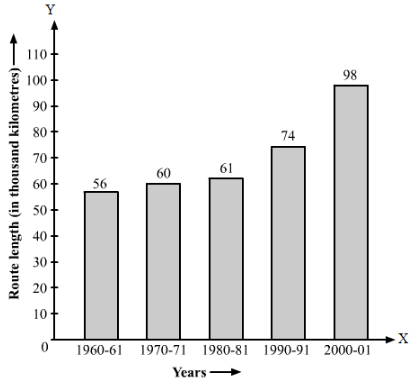
Mark the horizontal axis OX as “Years” and the vertical axis OY as “Route Length (in thousand kilometres)”.
Along the horizontal axis OX, choose bars of uniform (equal) width, with a uniform gap between them.
Choose a suitable scale to determine the heights of the bars, according to the space available for the graph. Here, we choose 1 big division to represent 1000 Km.
Question 9:
The following data gives the amount of loans (in crores of rupees) disbursed by a bank during some years:
| Year | 1992 | 1993 | 1994 | 1995 | 1996 |
| Loan (in crores of rupees) | 28 | 33 | 55 | 55 | 80 |
(i) Represent the above data with the help of a bar graph.
(ii) With the help of the bar graph, indicate the year in which amount of loan is not increased over that of the preceding year.
Answer 9:
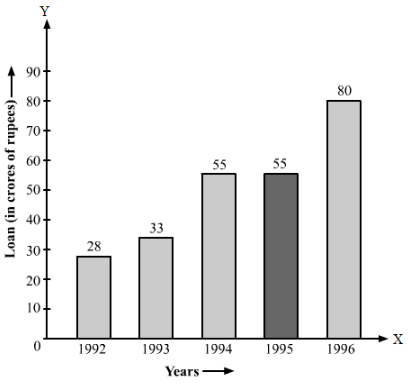
Mark the horizontal axis OX as “Years” and the vertical axis OY as “Loan (in crores of rupees)”.
Along the horizontal axis OX, choose bars of uniform (equal) width, with a uniform gap between them.
Choose a suitable scale to determine the heights of the bars, according to the space available for the graph. Here, we choose 1 big division to represent 10 crore of rupees.
In 1995, the loan amount was not increased over that of the preceding year.
Question 10:
The following table shows the interest paid by a company (in lakhs):
| Year | 1995-96 | 1996-97 | 1997-98 | 1998-99 | 1999-2000 |
| Interest (in lakhs of rupees) | 20 | 25 | 15 | 18 | 30 |
Draw the bar graph to represent the above information.
Answer 10:
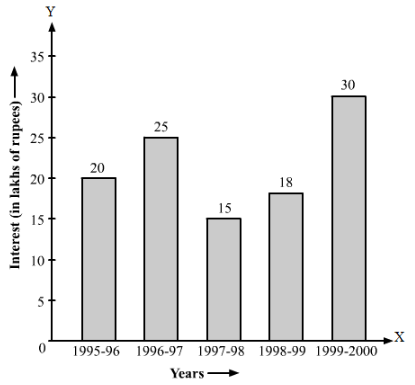
Mark the horizontal axis OX as “Years” and the vertical axis OY as “Interest (in lakhs of rupees)”.
Along the horizontal axis OX, choose bars of uniform (equal) width, with a uniform gap between them.
Choose a suitable scale to determine the heights of the bars, according to the space available for the graph. Here, we choose 1 big divisions to represent 5 lakhs rupees.
Question 11:
The following data shows the average age of men in various countries in a certain year:
| Country | India | Nepal | China | Pakistan | U.K. | U.S.A. |
| Average age (in years) | 55 | 52 | 60 | 50 | 70 | 75 |
Represent the above information by a bar graph.
Answer 11:

Mark the horizontal axis OX as “Countries” and the vertical axis OY as “Average Age of men (in years)”.
Along the horizontal axis OX, choose bars of uniform (equal) width, with a uniform gap between them.
Choose a suitable scale to determine the heights of the bars, according to the space available for the graph. Here, we choose 1 big division to represent 10 year.
Question 12:
The following data gives the production of foodgrains (in thousand tonnes) for some years:
| Year | 1995 | 1996 | 1997 | 1998 | 1999 | 2000 |
| Production (in thousand tonnes) | 120 | 150 | 140 | 180 | 170 | 190 |
Represent the above data with the help of a bar graph.
Answer 12:
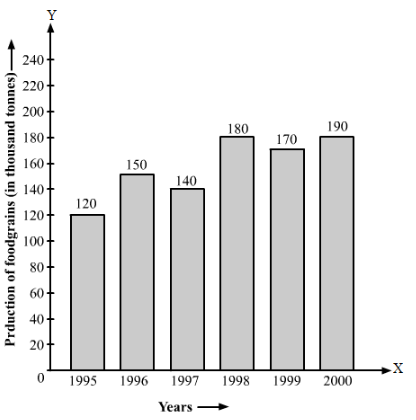
Mark the horizontal axis OX as “Years” and the vertical axis OY as “Production of foodgrains (in thousand tonnes)”.
Along the horizontal axis OX, choose bars of uniform (equal) width, with a uniform gap between them.
Choose a suitable scale to determine the heights of the bars, according to the space available for the graph.Here, we choose 1 big division to represent 20 thousand tonnes.
Question 13:
The following data gives the amount of manure (in thousand tonnes) manufactured by a company during some years:
| Year | 1992 | 1993 | 1994 | 1995 | 1996 | 1997 |
| Manure (in thousand tonnes) | 15 | 35 | 45 | 30 | 40 | 20 |
(i) Represent the above data with the help of a bar graph.
(ii) Indicate with the help of the bar graph the year in which the amount of manure manufactured by the company was maximum.
(iii) Choose the correct alternative:
The consecutive years during which there was maximum decrease in manure production are:
(a) 1994 and 1995
(b) 1992 and 1993
(c) 1996 and 1997
(d) 1995 and 1996
Answer 13:
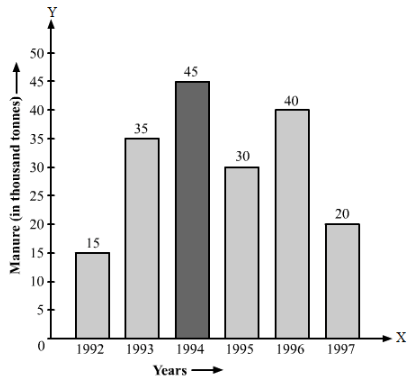
Mark the horizontal axis OX as “Years” and the vertical axis OY as “Manure (in thousand tonnes)”.
Along the horizontal axis OX, choose bars of uniform (equal) width, with a uniform gap between them.
Choose a suitable scale to determine the heights of the bars, according to the space available for the graph. Here, we choose 1 big divisions to represent 5 thousand tonnes.
(ii) In the year 1994 , the amount of manure manufactured by the company was maximum.
(iii) 1996 and 1997.
FAQs on Ex-24.1, Data Handling III Construction Of Bar Graphs, Class 7, Math RD Sharma Solutions - RD Sharma Solutions for Class 7 Mathematics
| 1. What is a bar graph? |  |
| 2. How to construct a bar graph? |  |
| 3. What are the advantages of using a bar graph? |  |
| 4. Can a bar graph have both horizontal and vertical bars? |  |
| 5. How can bar graphs be misleading? |  |

|
Explore Courses for Class 7 exam
|

|

















